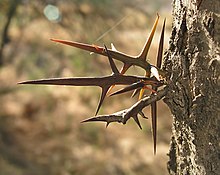Maria durch ein Dornwald ging
| "Maria durch ein Dornwald ging" | |
|---|---|
 | |
| Occasion | Advent, pilgrimage |
| Text | by unknown |
| Language | German |
| Published | 1850 |
"Maria durch ein Dornwald ging" (English: "Maria Walks Amid the Thorns") is a Christmas carol. By origin it was not an advent but a pilgrimage song that initially was spread verbally in the 19th century, starting in the catholic Eichsfeld.
Versions
The earliest known printed version with seven stanzas was found in 1850 in the collection of hymns from August von Haxthausen and Dietrich Bocholtz-Asseburg. The real time of origin of the song is unclear. Occasionally this song is dated in the 16th century, which at least may not be proved.[1] However, in the Andernach hymnal of 1608 a song ″Jesus and his mother tender″ was printed with the note "to the tune of Maria went through this forest," in which sometimes a nucleus of this Advent song is suspected.[2]
It was the song books of the German Youth Movement at the beginning of the 20th century, that procured the songs popularity. On the other hand, this effectuated its transformation from the pilgrimage to the supposedly popular Advent hymn. In 1910, the song appeared in the well-known today 3 stanza version initially published in the Jugenheimer Liederblatt. In 1912 the song was absorbed by the Zupfgeigenhansl and in 1914 issued in the Songbook ″Der Spielmann″ created by Klemens Neumann, co-founder of the Catholic Quickborn Youth Movement. In the Gotteslob, the current common prayer- and hymnbook of Catholic dioceses in Germany, Austria and South Tyrol, the song is edited with No 224,
Content
The first three stanzas describing the walk of Mary with the child "under her heart" refer to the pericope of the visit of Mary to Elizabeth as recorded in the Gospel of Luke, Luke 1:39–56. It is decorated with the motif of the dead thornwood, a symbol of fertility and death, which begins to bloom during pass of Mary with the divine child. The other stanzas circling around the catechetical question and answer format of the mystery of the Incarnation of God.
Literature
- Hans Breuer (editor): Der Zupfgeigenhansel. Hofmeister, Leipzig 1915.
- Klemens Neumann (editor): Der Spielmann. Liederbuch für Jugend und Volk. Burg Rothenfels, Quickborn, 1914 (later editions in Matthias-Grünewald-Verlag, Mainz).
- Hermann Kurzke, Christiane Schäfer: Eigentlich ein Lied aus der Wandervogelbewegung. In: FAZ Nr. 298, p. 6 of 22 Dezember 2011 (online, PDF, 467 KB).
Texts and translations
Notes
This section is empty. You can help by adding to it. (December 2015) |
References
- ^ August von Haxthausen, Dietrich Bocholtz-Asseburg (editor): Geistliche Volkslieder mit ihren ursprünglichen Weisen gesammelt aus mündlicher Tradition und seltenen alten Gesangbüchern. Paderborn 1850, S. 164–165. Zitiert nach der Onlinefassung im Historisch-Kritischen Liederlexikon des Deutschen Volksliedarchivs.
- ^ Theo Mang, Sunhilt Mang (editor), Der Liederquell. Noetzel, Wilhelmshaven, 2007, ISBN 978-3-7959-0850-8, p. 1017–1018.
